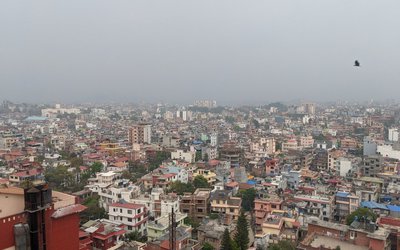
From the first day, Nepal’s climate induced crisis received international attention at the COP 26 Summit participated by the Head of the State, the Head of the Governments and high level delegation from 195 countries.
In his opening remarks, Alok Sharma, COP26 President, mentioned Nepal’s case along with other cases to illustrate to the world leaders how climate crisis is accelerating the natural disasters affecting the livelihood of people and forcing them to leave their homes.
“I have been humbled to speak over this year with communities devastated by climate change. On a visit to Jomsom in Nepal, in the Hindu-Kush region I spoke to communities literally displaced from their homes from a combination of droughts and floods,” shared president Sharma at the gathering in Glasgow.
“In Barbuda I met communities still suffering from the ravages of Hurricane Irma four years ago. I have spoken with communities in East Africa fighting plagues of locusts spawned by climate change. And earlier this month I spoke to a group of women in Madagascar, determinedly coping with what some describe, as the first climate induced famine in the world. In each of our countries we are seeing the devastating impact of a changing climate. Floods, cyclones, wildfires, record temperatures.”
The presentation of Nepal’s case in the inaugural speech was a significant achievement for Nepal. Not only on the opening day, the host UK Government whole heartedly backed Nepal’s position during entire COP26 summit.
“Fantastic to have Nepal take bold steps to aim for remaining cumulatively net zero carbon between 2022-2045 and carbon negative thereafter. Nepal’s drawn global attention with its community forestry model-it can do the same with carbon emissions,” U.K in Nepal tweeted.

With such a generous support and goodwill of host country, Nepalese political leadership also firmly expressed Nepal’s stand and commitment before the global community.
“Hon’ble Ramsahay Yadav, minister for Forest and Environment Announces a world leading commitment that Nepal will remain cumulatively ‘net zero carbon’ between 2022-2045 & become carbon negative after that, at Meeting Climate Business in Nepal,” tweeted UK in Nepal.
Nepal’s Stand
Addressing the World Leaders during the 26th Conference of Parties (COP 26) of the UN Framework Convention on Climate Change (UNFCCC) in Glasgow, leader of delegation and Prime Minister Sher Bahadur Deuba expressed that Nepal remains firmly committed to the implementation of Paris Agreement, which is evidenced by its ambitious NDC, the national plan to decarbonise Nepal's economy in all sectors and to reach a net zero emission by 2045.
He also urged the Parties to agree on a clear roadmap for a new collective, quantified and ambitious goal on climate finance before 2025. The Prime Minister said, "With abundant water, forest and biodiversity resources, Nepal can be a leader in sharing clean, green and nature-based climate solutions in the region."

PM Deuba urged the world leaders to recognize the specific climate vulnerability in the mountains and accord high priority to the mountain agenda in all climate-related negotiations. As all LDCs countries, Nepal has been facing severe damage from the climate induced disasters. Thus, Nepal has also raised the issue of loos and damage strongly.
PM Deuba underscored that loss and damage had become a key concern due to increased phenomena of climate induced disasters and called the Parties to agree on making Loss and Damage a stand-alone agenda for negotiations and agree on the framework of additional financing for it.
He said that the COP26 must ensure adequate support for adaptation in the most vulnerable counties by scaling up financial, technological and capacity-building resources.
From Nepal, a high-level delegation led by Prime Minister Deuba comprising the Minister for Forests and Environment Ramsahay Prasad Yadav and the Secretaries of various ministries, among the government officials took part in the summit. Similarly, various non-governmental organizations also sent their delegations.
The Ministry of Forests and Environment had made preparations for the country's participation in the COP26. As a Liaison Ministry for COP26 for Nepal, the Ministry prepared for the main conference as well as the side event where talks reached the final stage.
Nepal had made preparation to strongly raise issues in the COP26 like the impact of climate change on the entire Himalayan economy, on its ecosystem as well as on the ecosystem of the downstream region.
Besides this, topics as climate hazards, seeking resources for the implementation of the National Dedication Commitment (NDC) Report and Carbon financing were Nepal's priority in the COP26 meeting.

As Nepal’s preparation was effective, Nepal was able to show its presence in the conference as all the more effective this time," said Prem Narayan Kandel, secretary at the Ministry of Environment and Forest.
Nepal prepared the report on climate-induced hazards and losses, the National Adaptation Plan, NDC, Third National Communication (TNC), the Technological Needs Assessment (TNS), Gender and Social Inclusion Strategy and its action plan, so as to support the implementation of Paris Agreement.
“While accelerating climate crisis affects many parts of the world, the HKS region, impacts are felt particularly acute. This region, source of 10 major river basins, home to 1.9 billion poles, is the Pulse of the Planet, its health indicative for rest of the planet,” said Kebal Kiran, secretary at the National Planning Commission, addressing the high level meeting.
Secretary Kandel said a plan has been brought for reducing the GHG to zero in 2045 AD itself through the long-term strategy. "We have already presented the report on the financial source required for reducing the climate-induced damages and losses and to adapt to it." Nepal also expressed its commitment to increase forest coverage to 45 percent through community-based conservation programs.
Nepal has communicated its long term strategy just before COP26 with strong consideration and commitment to align it with sustainable development paradigm. Within 2045, Nepal’s aim is to achieve net-zero emission to build climate resilient society.
“Nepal highlighted its support for the Adaptation Action and signed the declaration on forest and land use. We are proud to have supported the government through the policy and institution facility. On Potential investment on low carbon development in Nepal using innovative financing instrument for clear and inclusive growth,” said secretary Kandel.
Some critics termed the commitments expressed through Nepal’s positions as contradictory and over ambitious. “Nepal’s commitment to zero emission is without solid programs.”

However, Nepal needs finance for all this. Nepal has pressed the developed countries to provide the amount that they have committed as compensation for carbon emission.
Secretary Kandel said Nepal emphasized facilitating the tools of financial assistance and having the government's direct access to it.
Nepal has already tabled its NDC Synthesis Report alongside other countries which would help implement the roadmap to reduce greenhouse gas emission to zero until 2050 as per the 2015 Paris Agreement.
Other goals of the agreement are to limit the world's average temperature increment rate to 1.5 degrees Celsius and not exceeding 2.0 degrees Celsius. Nepal is on the list of countries that have been most affected by climate change.
“We have prioritized climate change-induced disasters this time,” said Dr Radha Wagle, chief of the Climate Change Management Division under the Ministry.
Rain Loss
Just two weeks before the COP26, Nepal had suffered a huge damage by floods and landslides caused by extreme rainfall. According to the report, the rain and the disasters it caused have damaged rice crop worth Rs 7 billion throughout the country. Secretary at the Ministry of Agriculture and Livestock Development, Krishna Prasad Acharya said the off-seasonal rain and the floods it caused destroyed 258 thousand 92 metric tons rice cultivated on about 68,000 hectares land.
The highest damage is reported in Bardiya, Kapilbastu, Banke and Rupandehi districts of Lumbini Province. The damage in these districts is put at Rs 4.51 billion. The rain damaged 161 thousand 223 metric tons of rice cultivated on nearly 42 thousand hectares.
Similarly, 68 thousand 400 metric tons rice cultivated on 18 thousand hectares has been destroyed in Kailali and Kanchanpur districts of Sudurpaschim Province. The market price of the damaged paddy is Rs 1.91 billion.
The rain has damaged 28 thousand 469 metric tons rice cultivated on 7,492 hectares land in Jhapa, Morang and Sunsari districts of Province no 1. The market price of the damaged rice is Rs 800 million.

The farmers, especially in these regions, are facing difficulties due to the incessant rains that occurred in various places of the country since October 17. According to a preliminary report of the Ministry of Agriculture and Livestock Development, the floods and landslides have caused damages to paddy crops worth more than Rs. 7 billion in three provinces – Sudurpashchim, Lumbini and Province-1, said the ministry.
This will not be last for Nepal. The incidents are likely to repeat next year as well given the warming temperature. Loss and damage issue is important for Nepal in the circumstances.
Unfulfilled Global Commitment
Whatever commitments the countries like Nepal made, they would need funding. Countries like Nepal from the Global South, which have done the least to cause climate change but bear the brunt of its damages, fought for agreements on two key deals at the summit.
The first is to fulfill a broken promise made by rich countries at a climate summit in 2009 to give poorer ones $100 billion a year by 2020 to green their economies and adapt to climate change.
The second is to acknowledge their role in the losses and damages caused by increasingly extreme weather events like tropical cyclones and wildfires.
"That has been an issue that the rich nations have not wanted to address at all," said climate Action Network. The voices of poorer countries would be "critical" to ensure rich countries finance losses and damages.
"If the developed countries are serious, they need to show that leadership commitment," said Halima Bawa-Bwari, an environmental scientist at the Department of Climate Change, Nigeria, adding that many of the Nigerian delegation were missing meetings because they were commuting from outside the city.
Best Last Chance
The summit — hailed as the "best last chance" to limit global warming to 1.5 degrees Celsius above preindustrial temperatures — was an opportunity for world leaders to agree on deals that would stave off increasingly extreme weather.
The world has already got dangerous warming in the form of floods, record heat waves and wildfires, with a rise of just 1.1C. That's the natural world. But in the political world of COP26, things are looking a little brighter in the Glasgow sunshine.
Although expectations for this conference were low, the seasoned COP observers have been pleasantly surprised by a slew of announcements which suggest the world is on an unstoppable path to a low-carbon future.

Rich nations have clumsily failed to deliver their promised $100bn to poor countries by 2020. But the former Bank of England governor Mark Carney is looking to move trillions of dollars of private capital towards supporting clean technology.
He has gathered 450 organizations controlling 130 trillion dollars, or around 40% of global private assets, and they plan to shift finances to activities that help the move towards zero carbon, such as renewable energy. Critics complain the financial institutions will be allowed to invest in fossil fuels, but it's a serious and novel offer
Who isn't at the climate summit?
There are a number of notable absences from the talks. Xi Jinping, president of top carbon polluting nation China, and Russian President Vladimir Putin are both staying away.
President Recap Tayyip Erdogan also decided not to travel to Glasgow, the state-run Anadolu Agency said, without citing a reason for the change of plan. Reuter’s news agency quoted two unnamed Turkish officials, saying the trip was canceled after Britain failed to meet Ankara's demands on security.
"The president took such a decision because our demands regarding the number of vehicles for security and some other security-related demands were not fully met," the senior official told Reuters.
PM Modi’s Announcement
Indian Prime Minister Narendra Modi, however, has set aggressive targets for low-carbon power by 2030. Some people are worried that he doesn't plan to end greenhouse gases until 2070 - but the world will have changed completely by then, and India is likely to be forced economically come into step.
Indian Prime Minister Modi surprised domestic observers by announcing plans to cut emissions to net zero by 2070 at the conference. Two Asian leaders brought net neutrality pledges to the COP26 summit in Glasgow while China's president was noteworthy in his absence. Chinese President Xi Jinping, who has not left the country on official business since the COVID pandemic began, chose to skip the climate conference.
"The rest of the world looked at China and said 'what value are they providing?'" Biden said, adding that China was "walking away" from "gigantic" climate issues.
UK Prime Minister Boris Johnson said that while Xi's absence in Glasgow "doesn't mean the Chinese are not engaging'' with the fight against climate change, he urged China to do more to slash emissions.
Xie Zhenhua, a UN climate negotiator and special climate envoy for China, told reporters that China's status as the world's biggest emitter of carbon is due to the fact that the country is still developing.
He reiterated Beijing's stance that the US and other developed countries should be put under more pressure than China to cut emissions.
"We have already been making our biggest possible effort to address climate change,'' Xie said.”Regarding the fact that China is the current largest emitter, it's because China is at a special development stage,'' he added.
China submitted its updated nationally determined contributions — the non-binding climate change plans that are to be submitted to the UN as part of the 2015 Paris Agreement — on October 28.
How can world meet the 1.5 C climate target?
The Intergovernmental Panel on Climate Change (IPCC) has shown that emissions need to fall about 45% from 2010 levels by 2030. By 2050, they would have to reach "net zero" — where people are adding as much CO2 to the atmosphere as plants and technology are sucking out.
This could be done while growing the economy and providing everybody with stable and affordable energy access, according to a roadmap of 400 milestones published by the International Energy Agency (IEA) in May. However, achieving net-zero emission by 2050 "will require nothing short of the complete transformation of the global energy system," the authors wrote.
Here's how.
Underpinning the transition is the shift from fossil fuels to renewable energy. Starting today, that would mean approving no new oil fields, gas fields or coal mines, according to the report. All coal and oil power plants whose emissions aren't directly captured would be phased out by 2040.

Instead, solar and wind would become the leading sources of electricity by 2030 — and together generate nearly 70% of electricity by 2050. Nuclear power would double by 2050 to make up almost 10% of overall electricity generation.
Such a transformation would mean rich countries make all their electricity from low-carbon sources by 2035, with the rest of the world getting there five years later.
In India, the fourth-largest electricity market in the world, this would mean the end of a polluting coal industry. Across sub-Saharan Africa, where most people do not have access to electricity, it would mean avoiding investments in dirty infrastructure.
Despite many shortcomings, COP26 is meaningful for Nepal as Nepal’s recent climate related disaster received the global attention. Although some of the commitments Nepal has made at the global scale are ambitious and difficult to achieve, Nepal has now to start implementation of the new strategy.


- IME GROUP: Expands Into Paper Industry
- Mar 24, 2025
- CPN UML: Instigated By India
- Mar 23, 2025
- ADB’S CHIEF ECONOMIST: Nepal Reduces Poverty
- Mar 11, 2025
- FM DR. DEUBA: A Successful Visit
- Mar 11, 2025
- MD GHISING: Target Of Personal Grudge
- Mar 09, 2025















